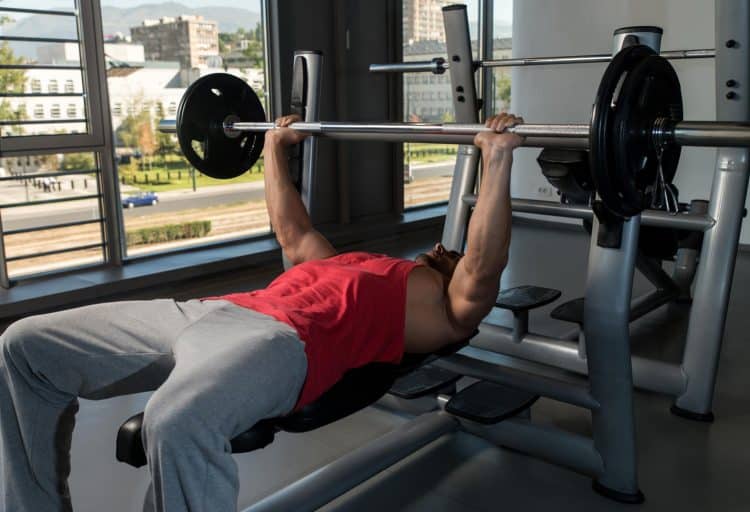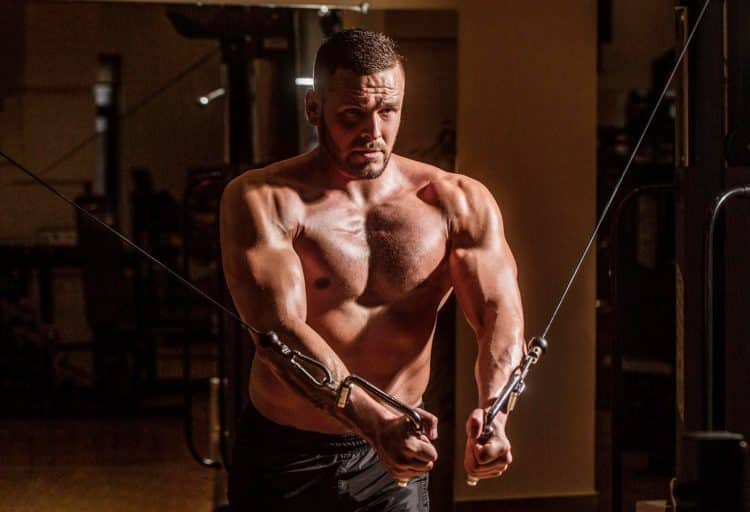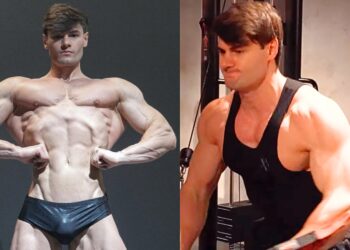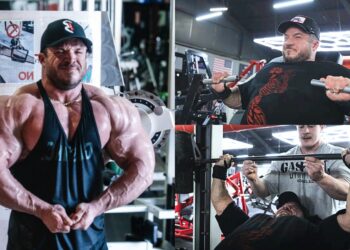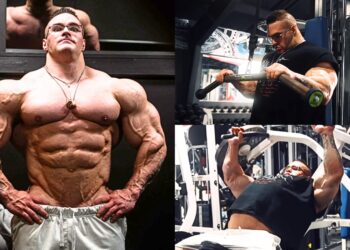The push-pull-legs (P-P-L) workout is one of the most popular training programs in bodybuilding. Even the legendary Austrian Oak Arnold Schwarzenegger used this split routine, and who can argue with the man who won seven Mr. Olympia titles?
With the push-pull-leg routine, you perform extension exercises on the first day, flexion exercises on the next, and then hit your lower body on the third day. You can do this cycle once a week or repeat it if you wish to train each body part twice a week.
This article provides you with not one but two push-day workouts to train your chest, shoulders, and triceps.
Before we learn more about push workout routines, let’s explore the types of training splits.
What are workout/training splits?
Whether the goal is to gain muscle or lose fat, we all must follow a roadmap to reach the objective. As the name suggests, a workout split is how you break down your workout into a training routine.
A workout split involves dividing your weekly workout routines by specific muscle groups or movement patterns.
Level Up Your Fitness: Join our 💪 strong community in Fitness Volt Newsletter. Get daily inspiration, expert-backed workouts, nutrition tips, the latest in strength sports, and the support you need to reach your goals. Subscribe for free!
To help you understand better, let’s have a look at typical workout splits:
- Full-body split
- Upper and lower body splits
- Push, pull, and legs
- Bro split
Full-body split
Full-body split involves training every major muscle group in a single workout routine. Full body split invokes muscle coordination and improves strength and muscle mass, which makes it suitable for beginners or someone who has resumed strength training after a long time.
Beginners should perform a full-body split at a lower intensity than intermediate and advanced lifters.
Here is why a beginner should not do a full-body split with heavy weights:
- It’s hard for the body to recover.
- It increases the chances of injuries.
A full-body split is usually practiced three days a week in order to allow sufficient recovery time. This kind of workout routine is also suitable for those who cannot workout every day.
Plan for a full body workout:
- Day 1: All muscle groups— Choose one exercise from every major muscle group, three sets, 10-12 reps.
- Day 2: Rest.
- Day 3: All muscle groups—Choose one exercise from every major muscle group, three sets, 10-12 reps.
- Day 4: Rest.
- Day 5: All muscle groups—Choose one exercise from every major muscle group, three sets, 10-12 reps.
- Days 6-7: Rest.
Common exercises to include in the full-body split:
- Chest: Bench press, incline bench press, or dumbbell press
- Deltoids: Shoulder press, lateral raises, Arnold press
- Back: Bent over row, pull-ups, T-bar rows, one-hand dumbbell rows, shrugs
- Legs: Squats, Romanian deadlift, glute bridges
- Arms: Barbell curls, dumbbell hammer curls
- Triceps: Dumbbell skull crusher, cable tricep pushdown, bench dips
Choose any one from each muscle group.
Upper and lower body split
This is where training starts to get a little demanding. The workout is divided into two training routines, one day for the upper body, the second for the lower body, and the third day for rest.
The number of exercises per muscle group increases to two. Here is how you plan your training:
- Day 1: Upper-body day—Two exercises for each muscle. Do three sets.
- Day 2: Lower-body day—Two exercises for each muscle. Do three sets.
- Day 3: Rest
- Day 4: Repeat Day 1
- Day 5: Repeat Day 2
- Days 6-7: Rest
Upper body: Chest, back, arms, and core
Lower body: Quadriceps, glutes, hamstrings, and calves
Note: One should not go heavy, especially when training every upper body muscle group in a single training session. Training all the upper body muscles in a single session can be pretty strenuous, especially for beginners.,
Push, Pull, and Legs
The push, pull, and legs routine is followed by intermediate and advanced lifters to gain muscle and strength.
While full-body and upper/lower workout splits were focused on targeting a specific body part, push, pull, and legs (P-P-L) concentrate on the movement pattern.
Push days train the upper body muscles responsible for extension, pull days train the upper body flexion movements, and then there is a day reserved for legs (including glutes).
Push day muscles: Pectoral major and minor, anterior deltoid (front delts), lateral deltoid, and triceps.
Pull day muscles: Latissimus dorsi, trapezius, posterior delts, and biceps.
Legs day muscles: Quadriceps, hamstrings, glutes, and calves.
Anyone with basic bodybuilding knowledge can follow push, pull, and legs training split. Generally, it is a six days per week workout routine. But you can follow your P-P-L split in three ways.
Option One
- Monday – Push
- Wednesday – Pull
- Friday – Legs
Option Two
- Monday – Push
- Tuesday – Pull
- Wednesday – Legs
- Thursday – Push
- Friday – Pull
- Saturday – Legs
- Sunday – Rest
Alternatively, you could use a revolving approach with flexible rest days where you train for three days in a row and then take one day off, like this:
Option Three
- Push
- Pull
- Legs
- Rest
- Push
- Pull
- Legs
- Rest
- Push
- Pull
- Legs
- Rest, etc.
Regardless of how you use it, the P-P-L routine is a great way to ensure you train all your major muscles equally.
Bro Split
A bro split is a widely used bodybuilding routine involving training a single muscle group a day. It’s a 5-6 day training protocol that emphasizes training a single muscle group. A typical bro-split looks something like this:
- Day 1: Chest
- Day 2: Back
- Day 3: Shoulders
- Day 4: Arms
- Day 5: Legs
- Day 6: Core
- Day 7: Rest
Although training one muscle group at a time might look enticing, a bro split allows you to train a body part only once a week, which might not be enough for optimum muscle gains. [1]
Push Day Workout To Build Muscle & Strength
So, why are we giving you two push workouts? The reason is that if you do two push, pull, and leg workouts per week, it’s usually best to avoid repeating the same program. Doing so can make your training boring and unmotivating. Alternating between two similar workouts will prevent boredom and burnout.
However, if you plan on only doing one push workout per week, just choose one, do it for 6-8 weeks, and then switch to the other.
Either way, these two workouts will ensure all your pushing muscles get the best possible workout.
Of course, to get the most from your training and reduce your risk of injury, you must prepare your muscles and joints before you touch the weights. Warm up with 5-10 minutes of easy cardio followed by some dynamic mobility and flexibility exercises for your upper body, such as the DeFranco Agile 8 program.
Complete your warm-up with a couple of light sets of your first exercise to dial in your technique and activate your muscles.
Push Workout #1
| # | Exercise | Sets | Reps | Recovery |
| 1 | Barbell bench press | 4 | 4-6 | 2-3 minutes |
| 2 | Incline dumbbell press | 3 | 8-10 | 60-90 seconds |
| 3 | Cable crossover | 2 | 12-15 | 30-60 seconds |
| 4 | Dumbbell Arnold press | 3 | 8-10 | 60-90 seconds |
| 5 | Cable lateral raise | 2 | 12-15 | 30-60 seconds |
| 6a | EZ bar skull crusher | 2 | 8-10 | 60-90 seconds |
| 6b | EZ bar close grip bench press | AMRAP |
Exercises 6a and 6b are a superset. So do a set of EZ bar skull crushers immediately followed by a set of EZ bar close grip bench press. Use the same weight for both exercises. AMRAP is short for As Many Reps as Possible, so just do as many as you can until you are unable to continue in good form.
Push Workout #2
| # | Exercise | Sets | Reps | Recovery |
| 1 | Dumbbell bench press | 4 | 6-8 | 2-3 minutes |
| 2 | Incline barbell bench press | 3 | 8-10 | 60-90 seconds |
| 3 | Wide grip chest dips | 2 | AMRAP | 30-60 seconds |
| 4 | Seated dumbbell clean and press | 3 | 8-10 | 60-90 seconds |
| 5 | Dumbbell lateral raise | 2 | 12-15 | 30-60 seconds |
| 6a | Reverse grip triceps pushdown | 2 | 8-10 | 60-90 seconds |
| 6b | Triceps pushdown | AMRAP |
Exercises 6a and 6b are a superset. So do a set of reverse grip triceps pushdowns immediately followed by a set of regular triceps pushdowns. Use the same weight for both exercises – just switch your grip. AMRAP is short for As Many Reps as Possible, so just do as many as you can until you are unable to continue in good form.
Exercise Instructions
Push Workout #1
There are two ways to do any exercise – the right way and the wrong way. The right way provides plenty of muscle-building tension for your muscles while minimizing stress on your joints and connective tissue. The wrong way is usually less effective and more likely to cause injury.
So, do the exercises the right way!
1. Barbell Bench Press
Target muscles: Chest, deltoids, triceps
While the squat is regarded as the king of leg exercises, the bench press probably holds the same title for your upper body. Go pretty heavy with this move to get plenty of tension in your chest, shoulders, and triceps. However, don’t go so heavy that you cannot do the exercise with perfect form.
You should not need to bounce the bar off your chest to complete your reps!
How to do it:
- Lie on the bench with your eyes directly beneath the barbell. Reach up and hold it with a slightly wider than shoulder-width grip. Press your upper back into the bench and drive your feet into the floor. Arch your lower back slightly and create lots of tension in the rear of your body.
- Unrack the bar and hold it over your chest.
- Bend your elbows and lower the bar down to the highest point of your chest. Tuck your elbows into your sides as the bar descends.
- Drive the bar back up to arms’ length and repeat.
Pro tip: Try to achieve a complete range of motion while controlling the tempo with a two-second eccentric motion.
Benefits:
- It’s a compound movement that develops a stronger and bigger chest.
- Bench press improves overall pressing power.
- It will help you burn more calories because of the large number of muscle engagement.
Best Rep Range:
- Hypertrophy: 10-12 reps
- Strength: 1-5 reps
Difficulty: Beginner
Progression: Board bench press
2. Incline Dumbbell Press
Target muscles: Chest, deltoids, triceps
The incline bench press emphasizes your upper chest. Also, you’ll have to work a little harder to keep your arms together, further increasing chest activation. Go a little lighter on this exercise, and focus more on pumping out the reps.
How to do it:
- Set your bench to a 20 to 30-degree angle. Lie on the bench with a dumbbell in each hand. Turn your wrists, so your palms are facing down your body.
- Bend your elbows and lower the weights to the outsides of your shoulders. Get a slight stretch and pause in this position for 1-2 seconds.
- Drive the weights up to arms’ length and repeat.
Pro tip: Bring the dumbbells closer as you push the weight up; it will help get a better chest contraction.
Benefits:
- Primarily targets upper pecs.
- Strengthens front delts.
- Using dumbbells fixes strength and muscle imbalances.
Best Rep Range:
- Hypertrophy: 10-12 reps
- Strength: 1-5 reps
Difficulty: Beginner
Progression: Incline cable bench press
3. Cable Crossover
Target muscles: Chest, deltoids
Your last chest exercise hits your inner, lower chest while minimizing triceps engagement. Use this move to squeeze any remaining energy from your pecs. Cable crossovers work best when you go slow and use light to moderate weights. Strict crossovers are effective crossovers!
How to do it:
- Attach D-shaped handles to the high pulleys on a cable crossover machine. Take a handle in each hand and stand in the center of the machine. Step forward into a staggered stance, extend your arms out to the side, bend your elbows slightly, and brace your core.
- Bring your arms forward and down, so the handles meet in front of your hips. Pause and squeeze your pecs for 1-2 seconds.
- Raise your arms and stretch your pecs.
- Continue for the desired number of reps.
Pro tip: Keep your elbows facing up to experience superior pec stretch. Try different pulley positioning to understand what works best for you.
Benefits:
- It’s an excellent chest isolation exercise that can help carve a well-defined chest.
- Cable crossover allows you the train the chest from different angles by bringing slight variations in pulley position and movement path.
- It keeps the chest under constant tension and improves mind-muscle connection.
Best Rep Range:
- Hypertrophy: 10-15 reps
- Strength: 5-8 reps
Difficulty: Beginner
Progression: Low-to-High Cable Fly
4. Dumbbell Arnold Press
Target muscles: Deltoids, triceps
This famous shoulder exercise is named after the patron saint of high-volume bodybuilding – Arnold Schwarzenegger. Arnold Press hits all three deltoid heads, making it a very complete shoulder exercise. After all that chest pressing, you won’t be able to go too heavy with this exercise, but that’s okay. The range of motion and constant tension means this exercise works well with light to moderate loads.
How to do it:
- Seated or standing, hold a dumbbell in front of each shoulder, palms facing toward you. Pull your shoulders down and back and brace your core.
- Press your elbows apart and simultaneously push the weights up and overhead.
- Reverse the movement and bring the weights back to your shoulders.
- That’s one rep – keep going!
Benefits:
- Arnold press facilitates a larger range of motion and activates all three shoulder heads.
- Helps develop well-defined rounded shoulders.
- Improves strength and control.
Best Rep Range:
- Hypertrophy: 10-12 reps
- Strength: 1-5 reps
Difficulty: Intermediate
Progression: Kettlebell overhead press
5. Cable Lateral Raise
Target muscles: Deltoids
Your final direct shoulder exercise targets your medial or middle deltoids, which are what give your shoulders their width. Using cables keeps your medial delts under constant tension, which will deliver a great pump. You’re only doing two sets, so make sure you take each one to failure.
How to do it:
- Attach a D-shaped handle to a low pulley machine. Stand side-on to the pulley and hold it with your furthest hand, so the cable crosses in front of your body. Bend your arm slightly but then keep it rigid. Brace your core.
- Raise your arm out and up until your elbow is level with your shoulder.
- Return to the starting position and repeat.
- Change arms and do the same number of reps on the opposite side.
Pro tip: Pause and squeeze your delts at the top for a couple of seconds for a better muscle pump.
Benefits:
- Cable lateral raise allows a bigger range of motion than dumbbell lateral raise.
- It keeps constant tension on the target muscle.
Best Rep Range:
- Hypertrophy: 10-12 reps
- Strength: 1-5 reps
Difficulty: Advance
Progression: Single-arm dumbbell lateral raise.
6a. EZ Bar Skull Crusher
Target muscles: Triceps
The final two exercises in your push workout hit your triceps. You’ve already used these muscles indirectly in the pressing movements, but it’s time to isolate them and finish them off. You’ll be doing two triceps exercises back-to-back, i.e., a superset.
How to do it:
- Lie on a flat exercise bench and hold an EZ bar with a shoulder-width grip, so your arms are vertical.
- Bend your arms and lower the bar down to the top of your head. Move your elbows and NOT your shoulders.
- Extend your arms and push the weight back up until your elbows are straight.
- Repeat for the required number of reps and then transition into the next exercise.
Pro tip: You can do it on a decline bench for better triceps isolation, activation, and hypertrophy.
Benefits:
- Improves size and strength of all three triceps heads (medial, lateral, and long head).
- EZ bar places relatively less stress on your wrists.
Best Rep Range:
- Hypertrophy: 10-12 reps
- Strength: 1-5 reps
Difficulty: Intermediate
Progression: Dumbbell skull crusher
6b. EZ Bar Close Grip Bench Press
Target muscles: Triceps, chest, deltoids
Where skull crushers isolate your triceps, close grip bench presses work them alongside your deltoids and chest. Using these muscles will allow you to push your triceps beyond their usual point of failure and also increases time under tension.
How to do it:
- Complete your last rep of skull crushers, and then hold the bar over your chest. Your grip should remain unchanged, i.e., hands shoulder-width apart.
- Bend your elbows and lower the bar down to your chest. Keep your elbows close to your sides.
- Drive the bar back up and repeat.
- Continue until you are unable to complete another rep in good form.
Pro tip: Focus on the tempo, two seconds concentric and four seconds eccentric.
Benefits:
- Strengthen triceps while also targeting mid-chest and delts.
Best Rep Range:
- Hypertrophy: 10-12 reps
- Strength: 1-5 reps
Difficulty: Beginner
Push Workout #2
This workout follows a similar format to workout #1, but the exercises are slightly different to prevent boredom and movement fatigue. As before, do each exercise with the best possible form to make them effective and safe.
1. Dumbbell Bench Press
Target muscles: Chest, deltoids, triceps
Some lifters find dumbbell bench presses more comfortable than the barbell version. That’s because your wrists and arms are free to rotate, which takes unwanted stress off your shoulder joints. Also, you can lower the weights a little lower, which may aid in hypertrophy.
On the downside, it’s harder to control two weights, so you won’t be able to go as heavy. So as both barbell and dumbbell bench presses are so effective, you’ll probably want to do them both in your workouts!
How to do it:
- Lie on a flat bench with a dumbbell in each hand. Hold the dumbbells over your chest with your palms facing down your body. Pull your shoulders down and back, brace your abs, and push your feet into the floor.
- Bend your elbows and lower the weights out and down to your shoulders. Pause for 1-2 seconds and get a mild stretch in your pecs.
- Drive the weights back up and together, and then repeat.
Pro tip: Shoot for a two-second concentric and four-second eccentric motion.
Benefits:
- The dumbbell bench press allows a greater range of motion than the barbell bench press.
- When done correctly, it prevents excessive stress on the shoulders.
Best Rep Range:
- Hypertrophy: 10-12 reps
- Strength: 1-5 reps
Difficulty: Beginner
Progression: Single-arm dumbbell bench press
Related: Dumbbell Bench Press Guide
2. Incline Barbell Bench Press
Target muscles: Chest, deltoids, triceps
The incline barbell bench press hits your upper pecs. This exercise tends to feel harder than flat barbell bench presses, so don’t go too heavy. You can do this exercise with a barbell or, if you prefer, you can do it on a Smith machine. The advantage of a Smith machine is the weight is guided by rods, so you don’t have to worry about balancing the load. You can also train to failure in relative safety.
Level Up Your Fitness: Join our 💪 strong community in Fitness Volt Newsletter. Get daily inspiration, expert-backed workouts, nutrition tips, the latest in strength sports, and the support you need to reach your goals. Subscribe for free!
How to do it:
- Set the angle of your bench to 20-30 degrees. A steeper angle tends to take the stress off your chest and shift it onto your shoulders.
- Hold a barbell over your chest with your arms straight, shoulders down and back, core tight, and feet planted firmly on the floor.
- Bend your arms and lower the bar to your upper chest.
- Extend your arms and drive the bar back up to arms’ length.
Benefits:
- The incline bench press emphasizes the relatively stubborn upper pecs.
- It also activates front delts.
Best Rep Range:
- Hypertrophy: 10-12 reps
- Strength: 1-5 reps
Difficulty: Beginner
Progression: Inclined dumbbell bench press
3. Wide Grip Chest Dips
Target muscles: Chest, deltoids, triceps
Before the bench press became the world’s favorite chest exercise, dips were at the top of everyone’s push day to-do list. Using a wide grip increases the range of motion at your shoulders, leading to increased chest activation. But, if you don’t have a wide grip dip station available, regular width dips are still a great chest exercise. However, your triceps will get a bit more of a workout.
How to do it:
- Use dipping bars that are wider than shoulder-width apart. The narrower your grip, the less chest engagement there will be.
- Place your hands on the bars with your palms turned inward. Support your weight on straight arms.
- Bend your knees and push your legs and hips as far back as possible. The greater the incline, the more pec activation there will be.
- Bend your arms and descend as far as you can without hurting your shoulders. Get a good stretch in your pecs. Allow your upper arms and elbows to flare outward.
- Extend your elbows and push yourself upward, stopping just short of lockout to keep the tension on your pecs. Push inward as well as downward to maximize pec engagement.
- Descend and repeat.
Pro tip: You can use resistance bands to assist your dips if you lack the required strength.
Benefits:
- A wide grip on this exercise results in better chest recruitment.
- Dips improve the pressing performance (especially bench press).
- It’s a compound exercise that also strengthened the triceps and shoulders.
Best Rep Range:
- Hypertrophy: AMRAP
Difficulty: Intermediate
Progression: Weighted dips
4. Seated Dumbbell Clean and Press
Target muscles: Deltoids, triceps
The seated dumbbell clean and press is an unusual exercise, and you won’t see many people doing it. The standing variation is much more common. However, as deltoid exercises go, the seated dumbbell clean and press is very effective, and you’re going to enjoy how quickly it fatigues your delts.
How to do it:
- Sit on the end of a flat bench with your feet on the floor and your torso upright. Hold a dumbbell in each hand, arms by your sides. Pull your shoulders down and back and brace your core. Turn your hands, so your palms face inward.
- Lean forward slightly from your hips and then explosively sit up straight. Use this momentum to help you raise the dumbbells up to shoulder height. Maintain your neutral hand position.
- Press the weights up and overhead from your shoulders to arms’ length.
- Lower the dumbbells back to your shoulders and then down to your sides.
- Continue for the prescribed number of reps.
Benefits:
- This single movement strengthens all three shoulder heads.
- Builds explosive strength.
- Enhances coordination.
Best Rep Range:
- Hypertrophy: 10-12 reps
- Strength: 1-5 reps
Difficulty: Advance
Progression: Single-arm dumbbell clean and press
5. Dumbbell Lateral Raise
Target muscles: Deltoids
Dumbbell lateral raises target your medial deltoids just like the cable variation. However, the load increases as you raise your arm, creating more of a peak contraction effect. That’s not to say they’re better than cable lateral raises – just different, and different can be all that’s needed to trigger muscle growth.
How to do it:
- Seated or standing, hold a dumbbell in each hand with your arms by your sides. Turn your wrists, so your palms face inward.
- Keeping a slight bend in your elbows, raise your arms up and out to the side to form a T-shape.
- Lower your dumbbells back down, and then repeat.
Pro tip: Focusing on slow and controlled eccentrics will improve hypertrophy.
Benefits:
- It’s an isolation exercise that targets the lateral/middle shoulder head.
- Helps develop cannonball delts.
Best Rep Range:
- Hypertrophy: 10-12 reps
- Strength: 1-5 reps
Difficulty: Beginner
Progression: Barbell upright row
6a. Reverse Grip Triceps Pushdown
Target muscles: Triceps
It’s triceps isolation time again! This time, you’ll be using two similar exercises to hit your triceps in two different ways. This pair of exercises is also a mechanical drop set as you’ll be moving from a weak biomechanical position to a stronger one. Best of all, these exercises will leave your triceps pumped and tired.
How to do it:
- Attach a straight or EZ bar to a high cable machine. Hold the bar with a supinated or palms-up grip. This is also known as a reverse grip. Pull your upper arms into your sides and brace your abs. Pull your shoulders down and back.
- Extend your arms and press the bar down to your thighs. Pause in this contracted position for 1-2 seconds.
- Bend your elbows, return to your starting position, and repeat.
Pro tip: Pin your elbows to your sides, and don’t let them flare or move forward.
Benefits:
- Isolate your triceps muscle while targeting all three heads.
Best Rep Range:
- Hypertrophy: 10-12 reps
- Strength: 1-5 reps
Difficulty: Beginner
Progression: Dumbbell skull crusher
6b. Triceps Pushdown
Target muscles: Triceps
Switching from an underhand to an overhand position puts your muscles in a stronger position, so you can pump out a few more reps and push your triceps even harder. There should be no need to change the weight – just flip your hands over and get to work!
How to do it:
- Using the same bar, hold it with a pronated or palms-down grip. Pull your upper arms into your sides and brace your abs. Pull your shoulders down and back.
- Extend your arms and press the bar down to your thighs. Pause in this contracted position for 1-2 seconds.
- Bend your elbows, return to your starting position, and repeat.
Pro tip: Bring your elbows a little forward to achieve superior muscle activation.
Benefits:
- It’s a triceps isolation exercise that lets you go heavy.
Best Rep Range:
- Hypertrophy: 10-12 reps
- Strength: 1-5 reps
Difficulty: Beginner
Progression: Bent-over triceps kickback
At Home Push Workout To Target Your Shoulders, Chest, and Triceps
You don’t really need a fancy set of equipment to do the push workout at home; you can use your own bodyweight to efficiently train those pushing muscles. Let’s have a look at a simple push workout plan.
- Push-up
- Feet-elevated incline push-up
- Diamond push-up
- Pike push-up
- Triceps dips
- Shoulder tap
The rest period between the sets should be around 60-90 seconds.
1. Push-up
Target muscles: Chest, shoulders, and triceps
* Perform three sets of 10-15 reps
Benefits: Pushup is a compound movement that can help build muscle mass and strength.
2. Feet Elevated Push-up
Target muscles: Upper chest and shoulders
Perform three sets of 10-12 reps
How to do it:
- It’s just like conventional a push-up, but you need to place your feet at an elevated position, such as a bench, chair, or stool.
Benefits: Placing the feet on an elevated surface puts more tension on the upper chest and front delts. Your triceps will also feel the burn.
3. Diamond Push-up
Target muscles: Chest and triceps

Perform three sets of 10-12 reps
How to do?
- Place your hands on the floor in such a way that your index fingers and thumbs are touching.
- Get into a high plank position.
- Place your hands under your chest.
- Now come down so your chest touches your hands
- Return to the starting position.
Benefits: Diamond push-ups focus on the chest (especially the inner chest) and triceps. They are similar to a close-grip barbell bench press.
4. Pike Push-up
Target muscles: Shoulders and upper chest
Perform three sets of 10-12 reps
How to do pike push-up:
- Get into the downward-facing dog yoga poses with your hands shoulder-width apart.
- Lift your hips high to form an inverted “V”.
- Bend your elbows to lower your face towards the floor.
- Exhale as you push yourself away from the floor by extending your elbows.
Benefits: Pike push-ups primarily focus on the upper chest and shoulders, but the triceps also plays a vital role in movement stabilization.
5. Triceps Dips or Bench Dips
Target muscles: Triceps
Perform three sets of 10-12 reps
How to do it:
- Sit on an elevated surface (bench or chair).
- Roll your shoulders back to open up the chest.
- Bring your hands directly underneath the shoulders and walk your feet out.
- Now bend your elbows to lower your hips towards the ground.
- As your elbow gets into 90-degree flexion, exhale and push yourself up by extending your elbows.
Benefits: It’s a great exercise to isolate the triceps. It not only helps in building bigger triceps but also improves your pressing strength.
6. Shoulder Taps
Target muscles: Shoulders and core
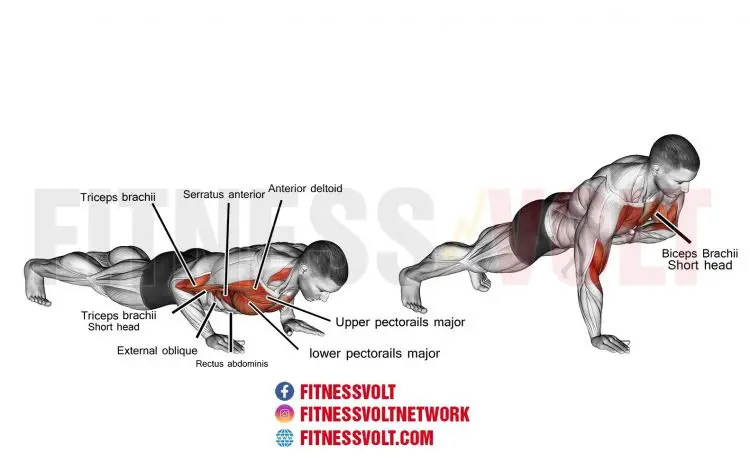
Perform three sets of 60-90 seconds hold
How to do it:
- Get into a high plank position with your feet placed hip-width apart.
- Keep your arms extended, back in a straight line, and core tight.
- Lift your left hand off the floor and tap your right shoulder.
- Return the hand back to the floor and repeat the same process with your left hand.
- Alternate between hands for the next 60-90 seconds.
Benefits: It’s an excellent exercise to strengthen the core and shoulders.
Benefits of a Push Workout
Selecting a push workout over a full-body or single-muscle training regime has multiple benefits. Let’s have a look at the major benefits:
1. Optimum recovery
Optimizing recovery time should be a top priority for maximizing strength and hypertrophy.
Push workouts provide optimal recovery and strength balance. It allows two to three days of rest before you train the same muscles again.
Plus, training six days a week allows you to train your push muscles (chest, shoulders, triceps) twice a week.
Are you wondering if training the upper and lower body also allows the same recovery time? Yes, but the workout intensity is considerably low during those training routines because of the volume. A P-P-L training split enables you to go hard without compromising recovery.
2. Hypertrophy benefits
Assuming you train six days a week, training a single muscle a day will allow you to train every muscle group only once a week. On the other hand, following a P-P-L regimen allows you to train all major muscle groups twice a week.
A 2016 meta-analysis to understand the best training frequency for optimum muscle hypertrophy concluded, “Training twice a week promotes superior hypertrophic outcomes to once a week.” [1]
Furthermore, training each muscle twice a week is a sweet spot to achieve optimal recovery and strength gains.
3. Uniform training
Most lifters focus their energies on training their favorite muscle group while neglecting the lagging muscles; this can cause muscle imbalance.
If you plan to do two exercises for the chest, two for the shoulders, and two for the triceps, there will be no room for negligence.
Furthermore, you could do additional sets for the weak muscles to fix strength and muscle imbalances.
4. Suitable for any fitness level
Whether you are an advanced lifter, beginner, or someone who just turned 50, a pish-pull-legs training routine is for everyone.
Advance lifters use push movement to optimize recovery while training two muscles weekly. Busy or older lifters can weight train thrice a week (with one push workout per week) for optimal recovery while still working on strength, Monday for the push movement, Wednesday for the pull movement, and Friday for the legs; that’s it.
Tips for a more productive push workout
Here are a few tips to substantially improve your push workouts:
1. Have a coffee before training
First thing first, having a cup of coffee 30-minutes before a workout is a great way to boost strength and focus and delay the onset of fatigue.
Additionally, caffeine also boosts fat burning by inducing lipolysis. [2]
2. Warm-up
Here is how warming up before a workout can help improve your push workout:
- As the name suggests, a warm-up increases your body temperature and gets the blood flowing towards the target muscles.
- All major joints get loosened up, which improves mobility to achieve a full range of motion.
- Warming up can improve your mind-muscle connection.
- You might experience better muscle contractions after warming up.
How to warm up? A warm-up is not about 10 minutes of jogging at a slow and steady pace; an effective warm-up should prepare the target muscle fibers for mayhem.
Warm-up for the push workout includes:
- Few arm circles to improve shoulder and chest mobility.
- Two sets of face pulls with resistance bands will activate the scapula and posterior delts.
- Two sets of plyo pushups activate the muscle fibers (especially fast-twitch) required for your push workout.
3. Pre-workout meal
Pre-workout meal plays a crucial role in powering a workout. Your pre-workout meal should provide all essential nutrients to get the best out of your training session.
A pre-workout meal should contain only two macronutrients—protein and carbohydrates. While protein aids in the fast recovery and repair of damaged tissues, carbohydrates replenish the muscle glycogen reserves to boost exercise performance.
One should consume slow and fast digesting carbs 45 minutes before the training session. Fast digesting carbs refill the glycogen reserves, and slow-digesting carbs maintain the supply of glycogen throughout the training session. Example: Oatmeal with a banana and a scoop of whey protein provides all the required macronutrients to supercharge your workout.
4. Strength train before the cardio
We recommend scheduling your cardio session after resistance training because cardio before strength training can deplete your glycogen reserves, which may hamper your lifting session.
Push Workout FAQs
1. Is this a bulking or cutting workout?
The main difference between cutting and bulking is your diet rather than the workout you are following. For example, if you eat 300-500 calories above your TDEE (Total Daily Energy Expenditure), you should bulk up and build muscle.
In contrast, if you reduce your calorie expenditure to 300-500 calories BELOW your TDEE, you should burn fat and get leaner.
So, adjust your diet according to your body composition goal. Eat more to build muscle and less to lose fat. Train hard to stimulate muscle growth or preserve your existing muscle mass during your cutting diet.
2. Can I change the exercises?
Providing you use similar exercises, you are free to make changes to the programs. However, don’t increase training volume or use different rep ranges.
The idea is to train with heavy weights for maximal muscle tension (exercise 1), moderate weights to create plenty of metabolic stress (exercise 2), and then moderate progressing to light weights to fatigue as many muscle fibers as possible (exercise 3).
Providing you stick with that format, changing exercises should have no real effect on your progress.
3. What does training to failure mean?
Training to failure means doing as many reps as possible with good form. This is also known as technical failure.
You’ll know you are approaching failure when your repetition speed decreases and you feel you need to take longer pauses between reps. Your facial expression will also change, and you’ll start to grimace. In short, you should feel that you cannot do any more reps without getting assistance from a spotter.
4. How long should I do this workout for?
Stick with this workout for 6-8 weeks or until you feel it is no longer productive. During that time, do your best to use more weight, do more reps, or just do each set with a higher degree of technical proficiency. These “micro progressions” are what keep your muscles growing.
Then, when you are ready for a new workout, use a similar approach but with mostly new exercises. Alternatively, revert to a lower-frequency, higher-volume chest program for a few weeks before returning to this workout.
5. I’m super sore after doing the first workout – is this a problem?
Muscle soreness is simply a sign that you’ve done something new and isn’t necessarily an indicator that anything is wrong or that you aren’t recovered from your last workout. If you are sore, spend a little extra time warming up and do 3-5 ramped sets of the first exercise to ease yourself into your workout.
For example:
- 20 reps (empty barbell)
- 12 reps 40kg/90lbs
- 8 reps 60kg/135lbs
- 3 reps 80kg/175lbs
- 6 reps 100kg/220lbs (1stwork set)
Soreness should become less of an issue as you become accustomed to this workout.
Push Workout Wrapping Up
The push-pull-legs workout has been popular for decades, which means it works. By grouping body parts by anatomical function and rotating muscle groups workout to workout, you can train hard and still get plenty of recovery between training sessions.
That said, the P-P-L workout is just one of many equally effective training splits. Other options include upper body/lower body, anterior/posterior, and body part splits where you train just 1-2 muscle groups per workout.
Ultimately, the best split is the one you can stick to.
Try the P-P-L workout and see how it works for you. If it’s not the perfect fit, move on to another approach until you find the one that works best for you.
References:
- Schoenfeld BJ, Ogborn D, Krieger JW. Effects of Resistance Training Frequency on Measures of Muscle Hypertrophy: A Systematic Review and Meta-Analysis. Sports Med . 2016 Nov;46(11):1689-1697. doi: 10.1007/s40279-016-0543-8. PMID: 27102172.
- Collado-Mateo D, Lavín-Pérez AM, Merellano-Navarro E, Coso JD. Effect of Acute Caffeine Intake on the Fat Oxidation Rate during Exercise: A Systematic Review and Meta-Analysis. Meta-Analysis Nutrients. 2020 Nov 24;12(12):3603. doi: 10.3390/nu12123603. PMID: 33255240.

